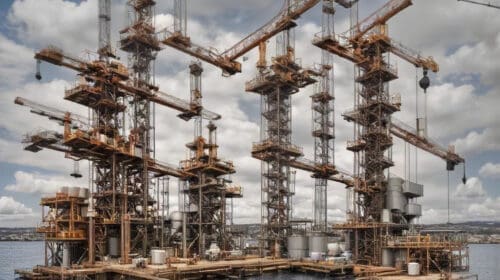The oil and gas industry is typically slow to respond to new technology outside of their comfort zone. They’re on par with the FAA’s inability to quickly create rules regulating unmanned aircraft systems (UAS)— also referred to as drones.
“The biggest surprise was around the very methodical approach this industry as a whole seems to take when it comes to embracing new technology,” Todd Chase, a program manager for UAS at Oceaneering, told Inside Unmanned Systems. “I understand where they’re coming from though. They’re very entrenched in the proven safety processes, which of course isn’t a bad thing. They want to stick with tools and processes that they know will work, and when the stakes are as high as they are for many of these organizations, this approach is understandable.”
The industry is turning around to embracing the benefits of using UAS in onshore and offshore applications. There are numerous benefits to using UAS technology ranging from safety and cost savings to enhanced data and less personnel.
“In many cases, drones are refining and augmenting something these people were already doing,” Chase said. “This technology enhances certain tasks and can eliminate the human footprint in a dangerous area to some extent, or minimizes exposure to risk.”
Upstream Use
Offshore operators can utilize UAS technology during design, construction, installation, and operation to ensure their asset performs as intended. There is no longer a need to send personnel out in the field to take measurements to add a new offshore structure. Unmanned aircraft systems have the capability to create a 3D model of the current structure and merge that information with a desktop CAD program that personnel will then use to continue the design of the new structure.
“I can bring in the file and upload it into a CAD-like program and draw the blueprints off that CAD program,” Clay Kroschel, CEO of Unmanned Ad-Hoc Industries, Inc., told Inside Unmanned Systems. “That mitigates days of overhead and traveling. Typically, guys would need to fly out to the oil rig and be out there for four or five days. Helicopters are expensive and take up valuable real estate on the rig. I can go out there on a boat and do a 15- or 20-minute flight and get the whole oil rig in a 3D point cloud, then bring that back to the client and put it in a CAD program.”
UAS eliminate the need to send workers out into the field, they offer better data, and they reduce the chance of mistakes.
Midstream Use
The use of UAS technology in pipeline inspection has increased the time it takes to collect data and essentially saves oil and gas companies plenty of money. However, the FAA prohibits operators from flying beyond direct line of sight.
That limitation makes this application challenging, Ian Glenn, CEO of ING Robotic Aviation, told Inside Unmanned Systems.
“Helicopters have the authority to fly. They’re dangerous and loud and not environmentally friendly, but they have the authority to fly. There’s absolutely no reason for them to fly when any of the drones we have would do a better job, cheaper and faster,” Glenn said. “We need the ability to fly 150 feet or lower down rights of way so we can better collect the data. It’s not a technology challenge; it’s purely an airspace access issue. With UAS we can get better data and rapidly push it out to those who need to make decisions based on that data.”
Besides the limitations, oil and gas companies are happy with the results UAS provide. They’re able to show exactly what the right-of-way looks like, use the technology in harsh weather, and assess wildlife conditions for new pipelines — all without leaving the office.
Downstream Use
UAS technology has been a useful tool for inspecting refinery and chemical plant facilities. Often times when inspecting a flare stack, the operator needs to shut it down. This leads to a loss of productivity when you shut down a major portion of the plant operation.
“Having a flare stack shutdown for manual inspection takes a week or more. It needs to be cooled down, then they have to bring it back up to its operating temperature,” David Proulx, VP of product and marketing for Aeryon, told Inside Unmanned Systems. “Then there’s the risk of having somebody visually inspect it. If you introduce a small UAS, you can keep the stack operating while you do routine maintenance and inspection of the infrastructure. You can perform the maintenance without having to shut down and without losing profits.”
The real value in UAS technology while using it downstream is safety. The technology allows operators to perform tasks without putting personnel in dangerous positions.
Challenges Ahead
Oil and gas companies are still uncertain about the full capabilities that UAS technology can do for their business. Companies are also uncertain about FAA regulations and how to meet legal and safety standards while using UAS technology.
“Most of them are not even thinking about UAS technology, but once we show them what it can do they’re just blown away. Especially with the cost savings,” Kroschel said. “A lot of them assume we’re talking about large military drones, but you can’t have a big drone like that around a chemical plant. It has to be a VTOL (vertical takeoff and landing) system. You have to get up close and personal, depending on what sensor the UAS is using and what information they need.”
The FAA is still writing rules and regulations that will shape the technology for future use. This prevents oil and gas operators from taking on the technology in-house. There are just too many steps and levels of certification and protocol you must follow to make use of the technology. The majority of oil and gas companies are hiring outside vendors to walk them through the technology and facilitate the entire UAS process to maximize its benefits.
The CEO of U.S. Energy Media, Emmanuel Sullivan is a technical writer who has built up his profile in the oil and gas industry. He lives and works in Houston, where he publishes Oilman and Oilwoman on a bimonthly basis, and Energies quarterly, distributing the magazine to energy thought leaders and professionals throughout the United States and around the world. At a time when technology is rapidly changing, he provides an invaluable service to oil & gas, and renewable energy executives, engineers, and managers, offering them both broad and specific looks at the topics that affect their livelihoods. Sullivan earned his BA in Communications at Thomas Edison State University and his MA in Professional Writing at Chatham University.












